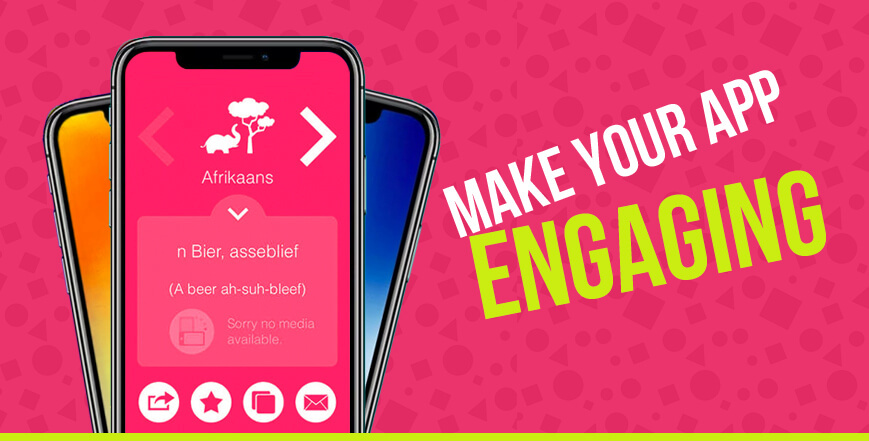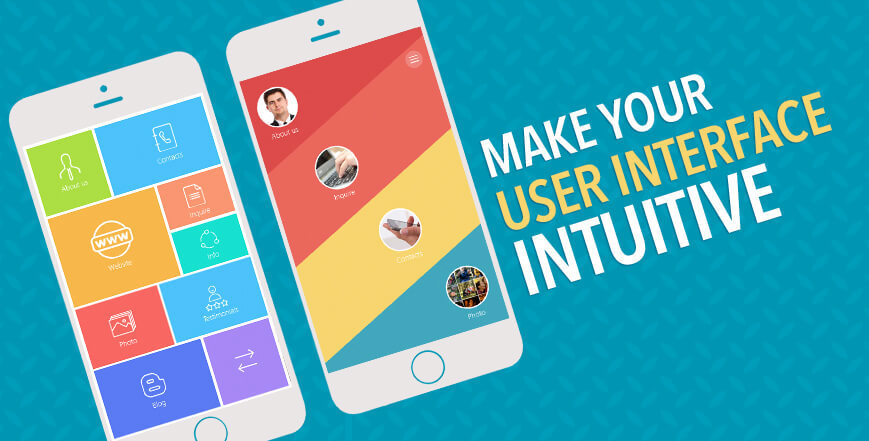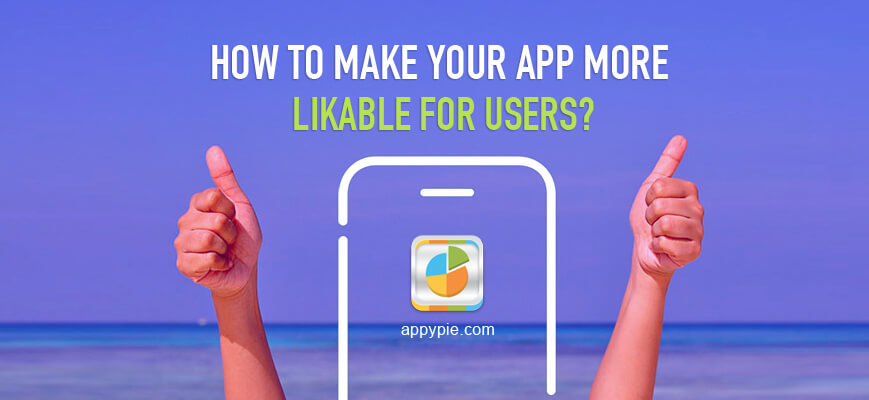How to Make Your App More Likable for Users?

Mobile apps might have been here for a comparatively short time but have flooded the market quite quickly. The app you are planning to build with great effort and research might not be something that many users would like. The mobile apps today are competing with each other in a furious fashion to find their place at the top of the list of popular apps. animations Your app might be the best thing that can happen in the world of mobile apps, but are you sure that the users you are targeting are going to like using it? The app you are building is for a certain audience, and if you cannot make a mark in their memories, your purpose would be grossly defeated turning your app into a failure. Here’s a sneak peek into what all you can do with an App:
- Boost your sales with a mobile catalog, store, loyalty program, coupons, and your choice of other features.
- Build customer loyalty by connecting to your customers with push notifications
- Go the extra mile by offering valuable information, an inviting loyalty program, exclusive discounts, and convenient tools for improving their lifestyle
- Become a part of your customers’ health goals with pocket tools added to the app
- Grab their attention with useful info, and sell more of your products with exclusive discounts and the convenience of mobile commerce
- Satisfy your diners with a lip smacking app that’s made to order
- Add your choice of features to let them check your menu, book a table, place an order, get directions, and more.
How Can You Measure Likability?
Measuring likeability is as tough as defining it. There are a lot of traditional and new age metrics that can be employed to measure the likeability of your app. Brand Mentions, Satisfaction Scores, and other traditional metrics in combination with new-age metrics including social media mentions, followers, email subscriptions, referrals, & NPS.Following are some of the signifiers that indicate that your app is likable among the users:- The users are talking about you.
- The users are following you on social media
- The users are referring you among their friends & family or other acquaintances (social media)
- The users are buying from you
- The users are coming back to you in order to buy more
- The users are spending considerable time on your app
- The users have been subscribing to your email list
- The users are reading your blog
- The users have taken to generating content for you
Ways to Make Your App Likable
Isn’t that something every app owner or aspirant want to know? Every app owner would like to see their app being liked by their users and for that to happen, it has to be engaging, useful, prompt, and shareable. It might seem to be quite a daunting task to begin with, but Appy Pie has compiled a list of ingredients or points that can help you make your app score higher on the likability scale!#1 Simplicity
Simplicity is one of the toughest things to achieve, yet it is most highly coveted as well. This is true even when you are building your app. Quite interestingly making your app simple is what adds a certain sophistication to it. If you have been laying too much stress on the workload of your app, chances are, you are making the entire app way too complicated for your target user to understand and to use. It is imperative that you keep the basic functioning of your app super simple, so that it is easy to use for the users and they do not have to struggle as they try to accomplish its primary function. The app needs to be quite clear from the very beginning. If your app needs you to spell out instructions, you are probably offering them an app that is way too complicated to be used with any level of enjoyment or ease.#2 High User Engagement
 The user might download your app in order to fulfill a certain need or solve a problem but might lose interest soon. Every product is designed for a particular target audience and when you want that audience or targeted user group to be engaged in your product, you quite simply have to make your product engaging. This is true for the app you are building as well. You have to make sure that the app has the ability to engage the audience you are targeting. It must establish a deep connection with the user. In order to determine whether your app is engaging or not, you must measure out all the possibilities based on the nature of the app.
The user might download your app in order to fulfill a certain need or solve a problem but might lose interest soon. Every product is designed for a particular target audience and when you want that audience or targeted user group to be engaged in your product, you quite simply have to make your product engaging. This is true for the app you are building as well. You have to make sure that the app has the ability to engage the audience you are targeting. It must establish a deep connection with the user. In order to determine whether your app is engaging or not, you must measure out all the possibilities based on the nature of the app.#3 High Accessibility
Any app that is built in such a way that it can only be accessed by a select few, would only be able to create a negative buzz. The negativity or any negative publicity has a way of spreading far and spreading fast and as an app developer or owner, you must not underestimate the harm it may bring. If the app is not available for everyone to use, it is going to witness a steep fall from grace. Similarly, if your app were to go through a function failure and you haven’t released an update for the newer version of the mobile devices or operating systems, you are going to have to pay heavily for it. If your app cannot be accessed by the target users, they are not going to be able to download it or use it. If the users are unable to download it, the app is certainly not going to be able to feature on the list of likable apps. Make sure that the app is accessible if you plan to make your app likable.#4 Design & Looks
The first impressions are possibly the deepest and looks or aesthetics play an important part in creating this first impression. In this era, where there are hundreds of thousands of apps in each category, if the app does not look appealing enough, users are not going to spare any time looking through it. If you make your app look professional as well as visually appealing, the chances of more buyers ending up on your app and keeping your app on their devices are higher.#5 Solve A Problem
When your app solves a problem, it is definitely going to have a special place in the minds of the app owners. Ask whether the users need this kind of problem solving. Ask whether the users would seek out an app like yours. State to your users what problem you are going to address, and how would your app solve this problem. As an example, if a user needs to find a cab home, then a taxi booking app is going to solve their problem of getting back home. These taxi-booking apps like Uber have a properly defined problem that they are solving. Most of the mobile device users would like to use an app to find a cab to get back home, instead of finding a website or making a call. They would look for an app that solves their problem efficiently and promptly would definitely be more likable.#6 Let It Become A Daily Need
If your app becomes something that the users are turning to everyday, then it becomes an integral part of their daily routine, promptly turning into something that they need to function successfully through the day. Any app that can be used on a daily basis quickly becomes totally irreplaceable at least for some time. As a developer, consider it your aim and intent to create an app that is instrumental in the progress of their day. The app should be designed to solve a long-term problem instead of something that is going to solve a short-term problem.#7 An Intuitive UI/UX
 As an app developer who is looking forward to making their app likable among their user base, it is important to pay attention to the smaller details and add the right mix of effects including animations, sound effects, transitions etc. to make the user interface interesting and user experience enjoyable. One of the most basic things is to create a layout which would make the content suitable for the size of the screen so that the users do not have to keep zooming in or out to make sense of the app content. Also, the user interface should take into account the size of an average finger to make sure that tapping on features is convenient.
As an app developer who is looking forward to making their app likable among their user base, it is important to pay attention to the smaller details and add the right mix of effects including animations, sound effects, transitions etc. to make the user interface interesting and user experience enjoyable. One of the most basic things is to create a layout which would make the content suitable for the size of the screen so that the users do not have to keep zooming in or out to make sense of the app content. Also, the user interface should take into account the size of an average finger to make sure that tapping on features is convenient.#8 Speed of The App
If the app doesn’t load with good speed, the users are not going to like using it and may even reject it entirely. Heavy apps load slowly, sometimes because the device specifications are not robust enough for them, which leads to app crashes. If your mobile app is offering an unoptimized and painfully slow experience, you are definitely going to lose out on a big chunk of your users. The most interesting thing here is that even if you are not offering a whole lot of features as compared to the competitors but are offering an optimized experience that is lag free, your app is going to be a lot more likable than others. Find that sweet spot of balance between the quality and performance of the app that will help you offer a high-performance app that does not compromise much on quality.#9 Intrusive Ads
Making a free app might be a strategic step that you took, taking into consideration a number of criteria, but you do need to make some money from it. To make this money, you would have to allow some intrusive ads somewhere on the screen. Even Facebook shows ads, but thankfully you can hide them, else they might become more than annoyance. If pop-ups, banners or any other promotional material come up everywhere then you are going to distract the users and may even lead them out of the app. Make sure that even if you are building a free app, you do not fill it with ads.#10 Integration with Social Media
This is an age of social media and it has turned into a powerful tool that can be used to promote your product and doesn’t require heavy investment either. When you integrate social media with the mobile app you become a part of a healthy competitive environment. Remember to add a convenient share option so that the users can easily share their experience with their friends and family on all social media channels. The promotion might be comparatively light on the pocket, but integrating social media with your mobile app would require you to invest a hefty amount to develop a secure encryption for the app.#11 Reach Out
Once you have taken care of all the above-mentioned points it is time you reach out to the masses with your app. Though there are a number of different ways to make the app known to people, but you would need to focus on ways that would make your app likable. Approach your target users, encourage them to provide a feedback and record them. Gathering and analyzing the feedback from users is one of the most crucial aspects and you should never think about launching your app on the app stores. Genuine feedback from the target user group is instrumental in determining the future performance of the app in the real market scenario. It can give you insight into the shortcomings of the app so that you can improve the app and make it ready for the market.How to Create a Likable App?
To create a highly likable app, we would recommend you to sign on Appy Pie’s AppMakr. It is a no-code app builder platform that let you build and publish from simple to complex mobile app. You can build app in three easy steps with the help of AppMakr:- Name your app and choose a category
- Build your app and add content
- Publish your app(though you’ll still have to wait for it to be submitted and approved before it shows up in any app stores).
- Naming your App: Your app’s name can be no longer than 30 characters and cannot contain any special characters, including apostrophes. However, if your business is called “Mike’s Salon,” or something similar, you can change the display name that appears at the top of the app in step two.
- Categorizing: You can categorize your app in one of the categories (this can be edited later), like business, law firm, restaurant, charity as well as a broad “other” category.
- Building your App: Appy Pie’s app builder features a “drag-and-drop” interface (which is actually more of a “click-and-fill-out-a-form” interface) alongside a large live preview of what your finished app will look like called the simulation mode. The builder has two main sections—“App Pages,” which is where we add and edit the different pages for your app; And “Style & Navigation,” which is where we edit how the app looks, including changing the background, icons, splash screen, colors, and navigation layout. You can now customize the exact way your app can look including its navigation functions with a variety of Themes, Backgrounds and templates to choose from.
- Adding Content to your App: In the App Pages tab, there are several boxes along the top of the screen, each of which represents a different page in your app.
Simply clicking on them would add that page to your app.To add a new page, simply click on the page in the layout below which has been clubbed into sections like:
- Information pages (about your company, contact, customer testimonials),
- Social media pages (Facebook, Twitter, Google+, LinkedIn)
- Multimedia pages (RSS feed, photo, video, blog)
- Mobile commerce pages (commerce, coupons, loyalty cards)
- Customizing Page Content: In addition to pre –set page layouts, some of Appy Pie’s pages let you build your own content:
- Form builder helps you create customized fill-able forms
- Quiz lets you build in a customized quiz into the app
- Text is a simple blank page that can be customized just the way you like
- Code page if you really want to build from scratch.
- Stylizing your App: Personally, this is the best part of the app process for I can change just about anything I want. From App Icons to splash screen to titles to themes to fonts, navigation, layouts and what not. You can also upload a new background image—only one for the entire app.The themes and backgrounds can transform any app into a superbly crafted piece of art.
Conclusion
There are a great number of ways to make your app likable and this list is not exhaustive. There are a number of different ways like rolling out app updates, advertising new features, giving out freebies, and many such other ways. It is important that you pick and choose the ways that suit you the best when you want to increase the likability of the app amidst millions of other apps in the market.Create Your Own AppRelated Articles
- Instagram Comment Bot | Learn All About Instagram Comment Bot
- Handling Angry Customers: A Guide to Excellence in Customer Service
- Sweater Weather Color Combinations: Style your Wardrobe with These Tips
- How Machine Learning Benefits Designers and Creatives
- The Entrepreneur’s Guide to Profit Margins: Maximizing Earnings
- How to integrate Facebook Lead Ads with Salesforce?
- Top 12 Essential Call Center Skills Every Agent Needs
- 5 GitHub Automation Ideas [How to Automate GitHub]
- Significance of AI Voice Generation Technology in Various Industries and Applications
- Lead Nurturing Mastery: Unveiling Strategies and Statistics for 2024
